Last week was Mobility Field Day 7. My good friend over at Celona, JR, gave an excellent presentation on deploying a CBRS network. It is a great next steps videos from my previous blog post about Celona. I highly recommend anyone interested in Celona go watch those. It shows how simple Celona is to deploy for regular network and wifi engineers. In a slack post, the Clear to Send guys recommended that everyone who watched MFD7 write a post about it within a week. I’ve been working on several posts specifically about Celona. So, I decided to start finishing some of them.
I’m working with Juniper Mist on a project at a school district this week with Juniper Switch and WAN, Mist Wifi, and Ruckus CBRS. Juniper’s presentations at MFD7 were excellent as well. So I might branch out into writing about that experience later this week. Those two were by far my favorite sessions.
I have been mulling over this post for a while. For about two years now, I’ve been playing with CBRS use cases as part of a pilot of school districts. I enjoy bleeding edge technology, so when Starlink was announced, I jumped at the chance to test it out. I figured I’d get a bunch of questions about it so I had better be prepared. I ordered Starlink about a year ago, but unlike many people on Reddit, received my Dishy McFlatFace about a week later. Then my mind soon started to ponder on how Private LTE in the CBRS Bands could work with Starlink.

My hesitancy to write this post has been due to the difficulty of leaving a home cell with Starlink. In the past roaming with Starlink was hit or miss and sometimes required jumping through a bunch of hoops. Well a few months ago, Starlink announced a $15 extra fee to allow traveling with Starlink away from the registered address. That has been the final piece holding me back, so here we go.
Starlink and CBRS: A match made in heaven

Starlink and CBRS are two technologies made for each other. A year ago, I attended the “Digital Divide Summit” virtual conference put on by Fierce Wireless. At that conference, visionaries in the Satellite internet community talked about how Satellite internet is going to be another tool in the belt in reducing the digital divide and benefiting Private LTE/5G rollouts. Elon tweeted about this very idea a few months ago, with someone replying about the idea of 5G running off of a Starlink dish.
Starlink in a lot of areas is reaching capacity. There are long lines and endless Reddit posts of complaints of people wanting better internet connectivity to their house. Just look at the east coast for unavailable Starlink cells on starlink.com/map. Much of the east coast falls under waitlists. I’ve been discussing the benefits of Starlink and CBRS working better together with districts from the mid-west.

There has to be a better way to more equally distribute this connectivity to those underserved students and users*. The best thing about CBRS is you only need one Dishy to cover a large area for relatively cheap.
The industry is paying attention and agreeing with this view. In educational circles they are calling Satellite Internet “Part of the Solution”. Often when talking about CBRS use cases, Education comes up as one of the first cases people talk about.
*Another side note, the Starlink Terms of Service are fuzzy in the area of sharing service. To cover your bases, if your plan is to share with your neighbors, it might be smart to look at Starlink Business to make sure you’re not breaking the agreements. For my use case and this example, I’m only using CBRS and Starlink for my own personal needs. I’m not sharing with others as I stood up the CBRS network temporarily. Consult your own lawyers if you plan to do this as more than a test.
The Hardware
My first attempt to connect a CBRS Radio to Starlink was back in January 2022. I’ve learned a few things since then. The Starlink equipment is pretty straight forward and has been discussed by numerous blogs. Although if you receive Generation 1.0 or 2.0, it will have some repercussions on the setup. I received Dishy Gen 1.0 equipment which comes with the Round Dishy, 100 foot ethernet cable, POE Injector, and a router with a second ethernet port. Dishy Gen 2, or Square Dishy, requires a separate adapter to connect anyway other than wirelessly, as all connections are proprietary and not standard ethernet.

Starlink provides by a Carrier Grade NAT (CG-NAT) IP address in the range of 100.64.x.x/10 and will NAT Translate all traffic to and from your network. This is a problem if you are whitelisting your CBRS Radios in a firewall. Every now and then someone may receive a random Public IP Address or some have got IPv6 working. My experience and from what I have read is that this can come or go unreliably. The Business plan provides a static IPv4 address so this isn’t an issue if your go that route.
From my experiences, I recommend either replacing the Gen 1 Router with something that supports a VPN or connecting a Router with VPN support to the ethernet port. That will add some encapsulation overhead but it seems to be minimal in my testing. For my network when I first set this up in January 2022, we used an enterprise grade router/VPN to connect the eNodeB to our network through the Starlink network.
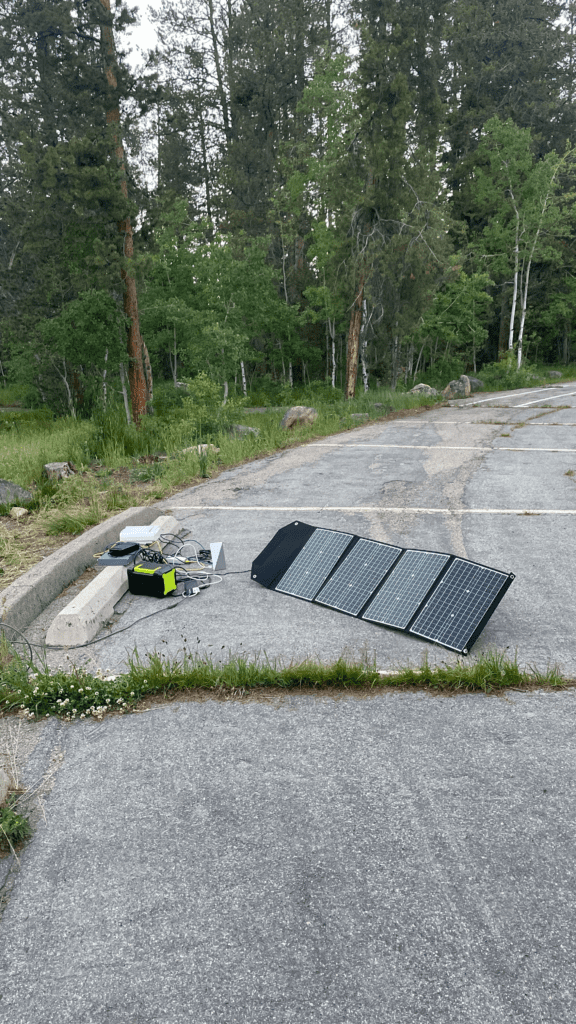
For my testing I used a a couple different radios. My first testing was with an indoor Ruckus Q710 CBSD Radio connected to an enterprise grade router. Later, as I talked about in a previous post, JR from Celona was kind enough to lend me a Celona Air, aka a Celona Cell in a Box. I had to test that out as well. Both are Category A eNodeBs or indoor models*. Celona actually has been testing this themselves and has a blog post about using Starlink as the Backhaul for their RAN.

*As with all CBRS networks, unless operating indoors at super low power, someone with a CPI Certification has to ensure the parameters are set correctly within SAS and certify the radio. This is to limit interference with incumbents in the band. Attaching a CBRS radio to a Starlink Dish doesn’t remove that requirement. Every time the setup is moved, someone with a CPI has to re-certify the radio. CBRS is not allowed on vehicles in movement including in flight; you have to certify it to an exact location, and that certification is tied to someone with a CPI. You can move them around between sites, but they have to be stationary and certified every time for a SAS grant to be awarded.

You need to ensure you have POE and power wherever you are planning to installed the different radios. For my testing I used a portable Solar Generator Battery. Running both Starlink and the CBRS Radios will drain the battery fairly quickly. Starlink, alone, lasted a couple hours on my battery, but adding the CBRS radios caused it last a lot shorter time period. Recently, there was a post about a guy that built a Solar Panel to power his Starlink in a remote location where power was not an option.
There are so many different vendors starting to build equipment for CBRS, so find whichever vendor works best for you and test it out. I had the Ruckus and Celona radios at my disposal for testing purposes, so that is why I chose those. If I was building something more permanent and needed to reach further than a quarter of a mile in all directions, I would go with sector antennas with an appropriate Class B outdoor eNodeB.
With our setup at my day job, I had to use a VPN to connect to our core. Celona’s Air cell in a box worked right in the box, because of their cloud architecture and the included Celona Edge. I did have a hiccup but got it working as soon as I figured out how their solutions works with SAS. Celona Edge can be deployed in two different scenarios, on the Starlink side (as in my case with the Celona Air and the Edge being in the box), or as an appliance in the cloud in AWS or at another of your sites. Celona’s documentation, about using their radios with Starlink, digs into the details. As I said before, the Celona Air Kit works with Starlink out of the box. Sadly they don’t sell it as just this kit, you would have to build your own. Plan accordingly before deploying.
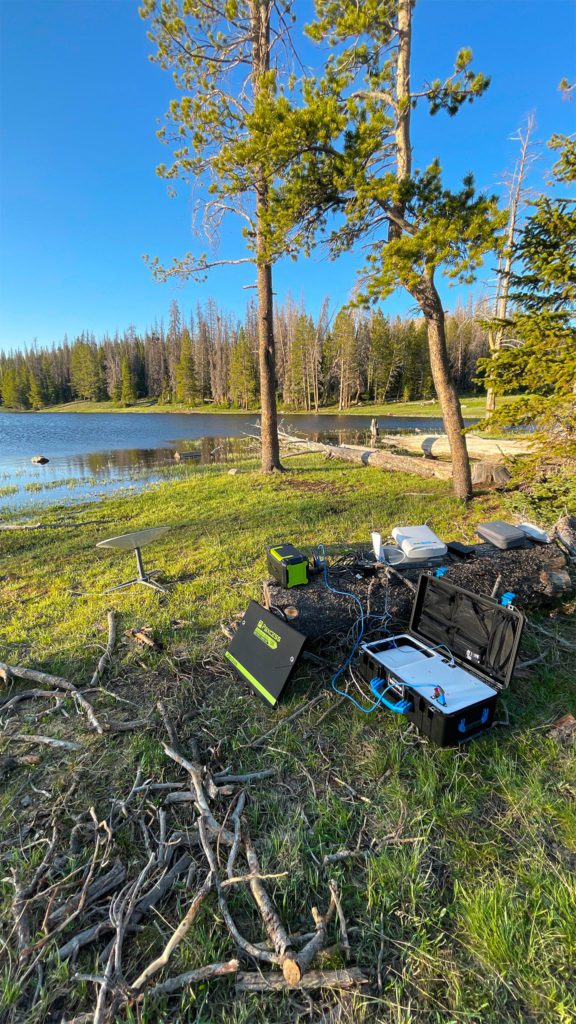
I recommend you create a Site in your eNodeB controller, like Celona Orchestrator, and place the Radio in the site well in advance of visiting your testing site. The reason being with how SAS is setup. You may arrive onsite and be unable to start broadcasting because the SAS sync between SAS Vendors hasn’t updated yet. The SAS vendors synchronize their databases roughly every 24 hours and sometimes this can cause issues for bringing a CBRS radio online. My first attempt with Celona Air failed because I thought I could create the site when I was on the mountainside. I’m finding that it may be an issue with using Google SAS. Celona has both Google and Federated Wireless SAS vendors configured on their demo units. One of my next tests is going to see if switching to Federated Wireless for SAS helps with that. Federate Wireless has a ESC Sensing Network deployed, Google kind of makes an educated guess. I recommend if you’re building this to test out your SAS provider.
The Experience
Starlink operates in Low Orbit so the experience is better than previous Geo Orbit Satellite services. That said, ask any hardcore gamer who has attempted to game on Starlink, you will get a response along the lines of it sucks. Starlink because of the very nature of Satellite internet has a long distance to travel up to space and back to earth before even hitting the fiber networks. Starlink by itself has high latency. Although, Starlink is improving the latency with additional launches of Satellites plus Satellite to Satellite communication without needing to come to a ground station.
CBRS, especially 5G CBRS, promises super low latency as one of the selling points. When it comes to this setup, if you are looking for low latency application with CBRS and Starlink, you may need to rethink your use case. My experience is with Starlink by itself, is speeds ranging from 10-300mbps depending on the time of day but ping times are in the 50ms on the low end to the 300ms in the high end. Streaming meetings on Zoom often have a lagginess and I have to repeat myself. Add a few milliseconds of latency to your calculations for the Private LTE/5G radios and then add additional latency for however the UE device will connect up with either Wifi or wired. My experiences with Wifi Calling on Starlink is okay but does suffer on occasion. The Starlink service since it is a shared resource can fluctuate depending on the time of day. I get better service in the mornings or in the middle of the night.

These are all documented results by many happy Starlink customers. As you build out these networks, don’t expect the greatest low latency. If you’re looking to cover an area, where Starlink is your only option and are willing to deal with these shortcomings, Starlink and CBRS together could be an absolute game changer.

Below is a Ookla Speedtest that I ran on my iPad connected to the Celona Air Kit connected to my Starlink Dishy. These are pretty typical speeds that I’m finding with CBRS. Not killer speeds compared to the Speedtest above that was just a test of Starlink, but that’s not necessarily the reason you would consider adding CBRS. This is a result of Celona using TDD Configuration Subframe Assignment 1 (SA1) by default. I haven’t found where you set TDD Config SA2 within Celona Orchestrator. SA1 provides equal Uplink and Downlink slots; while, SA2 provides more Downlink slots than Uplink. From a recommendation side, I’m starting to see more people recommend SA2 unless you’re installing indoors. All the Big Carriers, (Verizon and Tmobile) that are doing TDD networks, are using SA2 from my testing with my tools, so I’m changing all my CBRS networks to SA2.

The Starlink most likely won’t be your bottleneck. That will be CBRS. You can add multiple CBRS Radios to a Starlink Dishy to reach distance with Sector Antennas and Carrier Aggregation. Combined sector antennas and radios can cover a wide area up to a couple miles (our current record is 10 miles with usuable signal). This is all scheduled and you can guarantee the speeds at least on the CBRS side. It’s not guaranteed on the Starlink side.
In consulting with another school district in another state, who are looking at using Starlink to expand their CBRS network, the question came up about how reliable the network is. I sent the below screenshots to their team. This is from my own setup with Starlink mounted on my house. I have a tree that causes brief disruptions as you can see highlighted in red below.

This specific moment the screenshot below shows obstructions occurred 55 second over a 12 hour period. I had no signal aggregated for a 1 minute 23 seconds spread out over that 12 hour period. Finally Starlink had some network issue for 3 seconds over that 12 hour period that had nothing to do with my setup. This is all a major improvement to where Starlink was previously, as you may have witness with my instability of the video during my chat with the WLAN Pi Guys. More Satellites mean better service and less downtime.
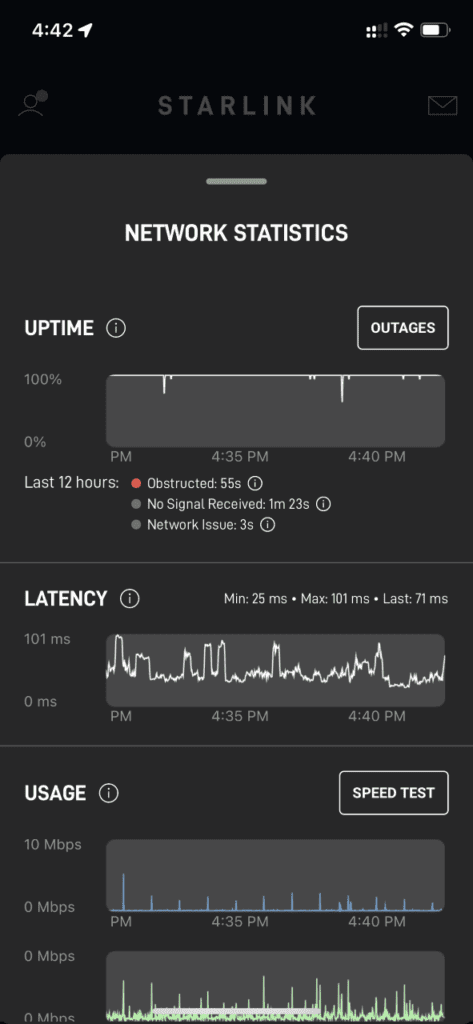
Future Plans
Currently, I have only installed this for testing and temporary purposes. I can see a huge use case for someone wanting to share it with several neighbors, if the Terms of Services are interpreted correctly. For our educational use case, I dreamt this up as a way to extend our network to areas that are going to be a challenge to reach. We have some super rural areas in the Southeastern portion of the state near Monument Valley where connectivity is super challenging. During COVID 19, others schools would drive buses that had Public Carrier LTE radios and Wifi Hotspots into neighborhoods to provide connectivity to students. I envision a school district potentially installing poles with solar power, installing a permanent Starlink Dishy, and connecting up a CBRS radio to reach other students nearby. I could see this being a big use case for school districts with areas that have a lot of remote houses or cabins but little internet options until the Telcos have the financial incentive to reach those students.
Outside of education, there are lots of potential use cases. In science, someone studying nature could install earthquake sensors or other sensors across a remote mountain side with a single Starlink and CBRS tower. Scientists would be able check in on the devices remotely without having to travel to each sensor. It may be more useful for using LORAWAN depending on the data being transmitted. Maybe cameras could be added to the site to monitor for wildlife.
The US National Parks Service has been exploring using CBRS in a Neutral Host model to provide connectivity at campsites and trailheads. Locations, where getting fiber connectivity is challenging or expensive, could be connected using Starlink. This would add emergency services to places where services has been unavailable previously. For more discussion about that see my previous post. Everyone is clamoring for neutral host, but as an industry we are awaiting the carriers before this becomes an option.
Starlink Long Term Viability
Lastly, I think I need to address the issues facing Starlink before I get flamed by trolls with this post. Starlink does have their detractors. Many because of their founder, Elon Musk; many because of the issues of placing thousands of satellites in the sky blocking stargazers; others because of the competition with Dish Networks and the 12Ghz Band; and many other because of the slowing of promised speeds because of roaming users.
I don’t have a crystal ball and have no clue where this is headed. I’m trying to avoid the politics and the heated debates about where Starlink should be allowed to operate in this blog. This past weekend, I found this post on LinkedIn. It fits in with some of the concerns I’ve been hearing while discussing this specific setup with school districts across the country.

Additionally, Dish Networks foray into using the 12Ghz band for their 5G network has their supporters and detractors. Starlink is doing an excellent job of using their subscribers to try to sway things. The two may be able to interoperate or they may kill each other. We will see how this shakes out. That will be left up to the FCC to decided, and I choose to focus on my little projects instead.
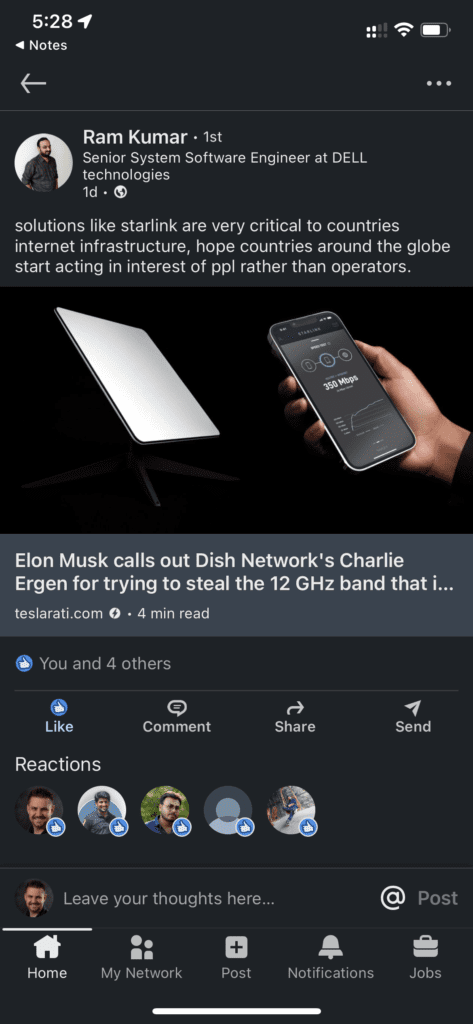
Cutting edge technologies often bring criticism and only history tells us how this will work out. I, like Michael Weening above, would love to have fiber networks connecting all parts of rural communities. My day job exists to help rural school districts with these needs. We connected my last school district with fiber a year an a half ago, in a very rural part of the state, through a federally e-rate funded grant that cost into the of millions of dollars. Eventually fiber will be installed in more places and more people will have the benefit. For now, go read the reddit posts from all the rural users who don’t have other options. For them, Starlink is a god send. Until there is a financial incentive for rural telcos, that’s not going to change any time soon. I do know that Starlink is fitting a need that is not being served by any other service.
Like I said before, Starlink and CBRS can operate together to help reduce some of these issues. Instead of every house having their own dish, why not connect a group of houses together with a CBRS Fixed Wireless setup?
Conclusion
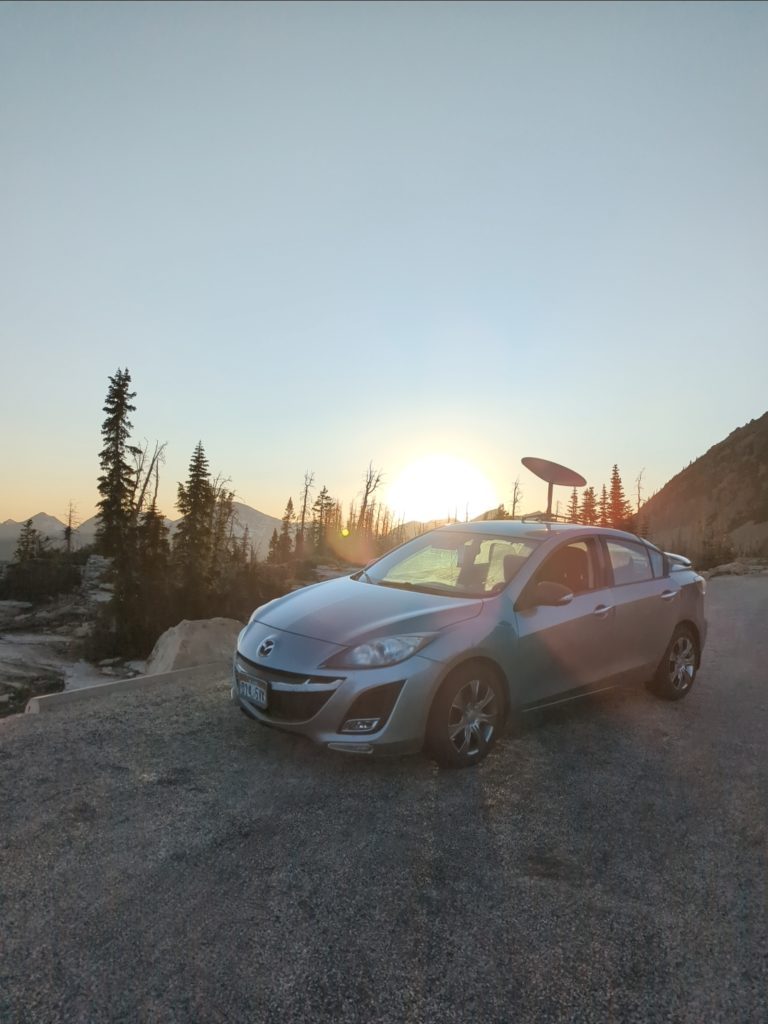
I can see Starlink and CBRS working together as another tool in our tool belts. Sometimes there are locations where we have no other option. If you need to cover one of those areas over a large area, CBRS and Starlink would be one of my first choices. If you can get fiber to a site, then absolutely use that, but in the interim or because it’s super expensive or near impossible, use Starlink with CBRS. Just as CBRS and Wifi are complimentary in certain use cases, use this where the requirements dictate. The technologies can be symbiotic.

